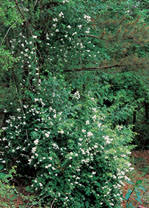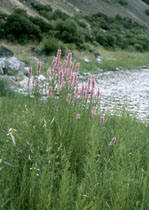|
Lythrum - A Noxious Weed
Mary Ann Ryan
Adams County Master Gardener
 Most of us understand the concept of invasive plants. An invasive plant is one that has become a weed
pest. It is a plant which grows aggressively, spreads, and displaces other plants. They tend to appear on disturbed ground and some can invade existing ecosystems. Some have escaped from cultivation and can dominate whole areas. Invasive plants are environmentally
destructive and can be extremely expensive to control. Most of us understand the concept of invasive plants. An invasive plant is one that has become a weed
pest. It is a plant which grows aggressively, spreads, and displaces other plants. They tend to appear on disturbed ground and some can invade existing ecosystems. Some have escaped from cultivation and can dominate whole areas. Invasive plants are environmentally
destructive and can be extremely expensive to control.
|

Multiflora Rose
Rosa multiflora
|

Purple Loosestrife
Lythrum salicaria
|
Some of the species of invasive plants include mile-a minute, Johnson grass, multiflora rose, and purple loosestrife. Many folks are familiar with mile a minute, a very aggressive vine that has tiny thorn-like protrusions on the stem, giving it another name of tear thumb.
Johnson grass is often spotted along the edges of farm fields or in disturbed areas; and multiflora rose is seen everywhere-along woods' edges, in hedge rows, in meadows-it's not at all particular to soil type or location. Purple loosestrife, or Lythrum, is a perennial that
has been propagated and distributed throughout the United States. This plant gets a pretty purple spike blooming from July through early September. It has been used in our home landscapes for many years. It was introduced from Europe in the 1800's and will grow in most
soils, but especially loves moist soil.
So what's wrong with this plant? Purple loosestrife is an aggressive plant that is invading our wetlands and replacing valuable wetland plants. Wetlands are the most biologically diverse, productive component of our ecosystem. Hundreds of species of plants, birds, mammals,
reptiles, insects, fish and amphibians rely on healthy wetland habitat for their survival. Lythrum is choking waterways and eliminating food and shelter for wildlife. It grows in dense thickets and crowds out native plants that wildlife use for food, nesting and hiding
places, while having little or no value or wildlife itself.
For example, songbirds will not eat the small hard seed. Muskrats require cattails to build their homes. Ducks avoid wetlands that are dominated by loosestrife. Loosestrife becomes too dense to provide adequate cover, which is crucial for wildlife. The dense roots and
leaves of purple loosestrife choke waterways, slowing the natural flows and promoting the deposit of silt, which causes water quality to decrease and costly maintenance of dredging and cleaning the drainage ditches.
Unfortunately, there are no natural predators, specifically insects, diseases or animals which attack the purple loosestrife. This makes the plant even more prolific in our wetlands. In Europe, Lythrum's native habitat, there are natural predators for this plant, keeping it
in check, just as our native plant populations are kept in balance by natural predators here.
How can we control this plant? Pennsylvania has declared Loosestrife as a noxious weed. The inclusion of loosestrife cultivars was added to the noxious weed list in November, 2000. This means that "it is illegal to propagate, sell, or transport these weeds in the
Commonwealth" PA Bureau of Plant Industry. This is to prevent further spread of this invasive plant.
Here are some ways that you can prevent further spread of loosestrife. 1. Don't plant it. Even Lythrum varieties advertised not to make seeds can cross-breed with the invading loosestrife to make seeds. 2. Be on the lookout for pioneering plants or isolated small colonies,
especially in areas otherwise free of loosestrife. Remove pioneer plants immediately. 3. Rinse off equipment, gear, clothing and footwear used in infested areas before moving into uninfested areas. 4. Cut off flower heads, bag and destroy them. Repeat throughout the
flowering season (late June - early September). This will prevent millions of seeds from ripening and spreading." PDA Bureau of Plant Industry
If you have existing plants, you need to control them. For young plants, just pull them, bag and destroy the plants. You can dig older plants, but must be sure to remove all the roots, as remaining roots will sprout more. If you are cutting them, the cut stems will just
sprout new shoots and roots, creating even more of a problem.
Take this noxious weed seriously. It is as dangerous as mile a minute or multiflora rose. Purple loosestrife may be beautiful in the garden, but the potential degradation of our wetlands because of this invasive plant is grand. Look for other alternatives in the garden.
There are many perennial plants that will shine just as brightly!
Read other articles on lawn care & weed control
Read more articles by Mary Ann Ryan |